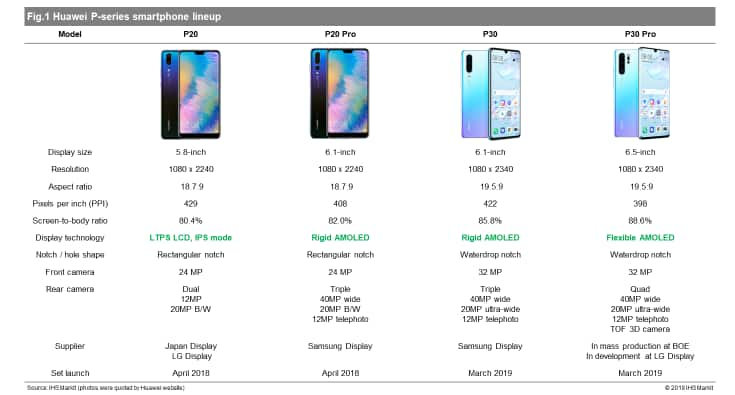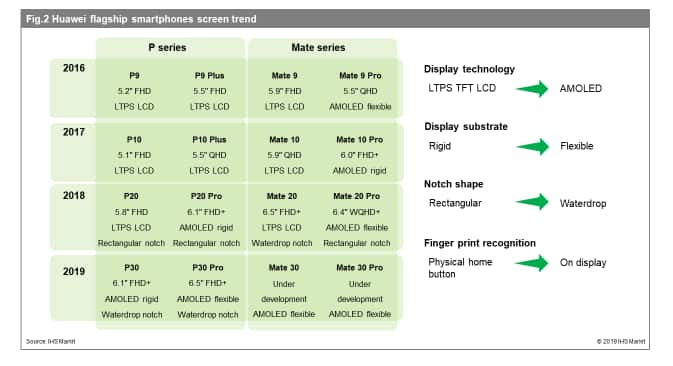At its launch event in Paris in March this year, Huawei unveiled
two new smartphone models, the P30 and P30 Pro, as the latest
additions to its flagship P30 line.
Last year, Huawei had chosen to use two technologically
different glass-substrate-based displays for its P20 and P20 Pro
models. The P20 display is a 5.8-inch full-high-definition-plus
(FHD+) low-temperature polysilicon thin-film-transistor (LTPS TFT)
LCD with screen resolution of 1080 x 2240 pixels. The P20 Pro
display is a 6.1-inch FHD+ rigid AMOLED with the same screen
resolution as the P20.
This year, however, Huawei elected to use AMOLED for its new P
series, changing the display’s shape and aspect ratio to support
more full-screen features. The P30 display is a 6.1-inch FHD+ rigid
AMOLED with 19.5:9 aspect ratio and screen resolution of 1080 x
2340 pixels. In comparison, the P30 Pro display is a 6.5-inch FHD+
flexible AMOLED with the same aspect ratio and screen resolution as
the P30. Furthermore, the notch design in both displays have been
changed in shape from a rectangle to what resembles a drop of
water.
The figure below shows the Huawei P-series smartphones,
including the two newest models in its P30 flagship lineup.

The switch to AMOLED has impacted the company’s display supply
chain.
In 2018, both Japan Display and LG Display provided the LTPS TFT
LCD panels for the P20, while Samsung Display supplied the rigid
AMOLED panels for the P20 Pro. With the adoption of AMOLED for the
P30 series, the LTPS TFT LCD suppliers were booted from the supply
chain, opening the door for China’s BOE to take their place.
Since then, BOE has become a successful supplier of flexible
AMOLED, with panel shipments increasing sharply from Q4 2018 after
starting up delivery for the Huawei Mate 20 Pro. BOE has also been
victorious in supplying flexible AMOLED for the P30 Pro, with the
maker able to maintain stable production. LG Display, meanwhile,
has the capability to supply displays for both the P20 and P30 Pro,
yet appears to struggle in beginning the mass production of
flexible AMOLED for the P30 Plus.
Overall, Chinese smartphone OEMs are increasingly adopting
AMOLED for high-end smartphones. This is also true of Huawei, which
is rapidly replacing LTPS TFT LCD with AMOLED on its flagship
smartphones, as the figure below shows.

With a self-emitting display, AMOLED achieves wider contrast
ratios and faster response times at the same time offering a
thinner and lighter display module, compared to a TFT LCD display.
AMOLED can also support flexible-display forms and
fingerprint-on-display—features that TFT LCDs cannot provide.
On top of those advantages, current market conditions favor AMOLED:
the number of suppliers capable of producing flexible AMOLED is
growing, the quality of AMOLED display panels is improving, and
AMOLED panel prices are gradually decreasing. All told, these
factors have led smartphone OEMs to adopt flexible AMOLED in
growing volume for their premium and high-end line of
smartphones.
Huawei’s use of AMOLED for its two newest smartphones confirms
the company’s commitment to AMOLED technology, with significant
implications for AMOLED manufacturers. Despite being among the
world’s top 3 smartphone companies by shipment volume—it moved
up recently to second place after sweeping past Apple and now just
trails Samsung—Huawei’s adoption rate of AMOLED is relatively
low among the world’s top 5 smartphone manufacturers.
For years, Huawei opted to use TFT LCD displays for its high-end
models, not AMOLED. When competitors began adopting AMOLED for
their premium lines, Huawei stood firm and did not change its
strategy on TFT-LCD. Huawei’s shift to AMOLED—first with the
P20 phones and now with the P30 models—should then be viewed
with great interest. It is the clearest signal yet—to the
displays market and to other smaller display manufacturers watching
to see how Huawei would act—that the world’s No. 2 smartphone
manufacturer is now fully committed to AMOLED as the display
technology of choice for its premium phones.
That, in turn, can motivate AMOLED makers everywhere to step up
production of AMOLED panels. The end-result could see AMOLED makers
increasing their share of the smartphone displays market—a most
welcome win for the AMOLED space.
Brian
Huh is principal analyst for small/medium displays at
IHS Markit
Posted 1 July 2019